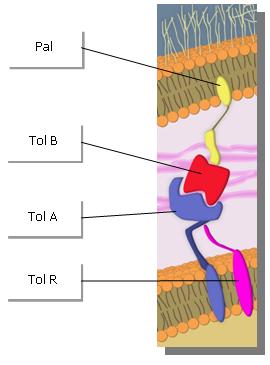Team:Paris/Production overview
From 2009.igem.org
iGEM > Paris > Vesicle production system > Overview
Contents |
Overview
Introduction
Several gram-negative bacteria - including E. coli - have been shown to produce vesicles for various hypothetical reasons[1][2] (stress response, host-pathogen interaction...). In our project, we want to optimize vesicle production to develop a long distance communication system between gram-negative bacteria. Outer membrane vesicles (OMVs) production can be enhanced through the destabilization of the outer-membrane. We found in the literature that the Tol/Pal system could be a good target for this purpose[3]. The Tol/Pal system of Escherichia Coli is involved in anchoring the outer- to the inner-membrane and to the peptidoglycan layer. It is thus essential in maintaining membrane integrity. The system is composed of five membrane proteins (TolA, TolB, TolQ, TolR and Pal) associating in two complexes.[4][5]
See Tol/Pal part for more information and why we choose this system. Strategy and Construction part explains our aim in this OMV production system.
A. Tol/Pal
E. Coli is gram-. Its membrane is complex included: the inner membrane and the outer membrane. Between both, there is a layer of peptidoglycan. The outer membrane presents lipo-polysaccharides (LPS). We find also porins and other proteins. There are receivers for the entrance of nourishing elements, receivers in pili ( bacterial conjugation), receivers where settles bacteriophage. It has properties of selective permeability, protection and support. This complex of proteins is in place to maintain the stability between the inner membrane and the outer membrane.
In particular the system called Tol-Pal consisted of five proteins, TolA, TolB, TolQ, TolR and Pal[1][2]. This complex allows to maintain the integrity of the membrane. Studies showed that if we destabilize this system, we also destabilize the membrane, leading then a production of vesicles. But when the membrane of the bacteria stays for such a long time in this state of destabilization, the bacteria produces too many vesicles and go in state of lysis[2].
What is Tol-Pal complex ?
The five proteins organised this complex[3]. The TolA/Q/R proteins form a protein complex in the inner membrane. TolB is a periplasmic protein associated with Pal, a lipoprotein. Pal is anchored to the outer membrane and interacts with the peptidoglycan layer. There are interactions with TolA–Pal and TolA–TolB.
References
- ^Transmembrane a-helix interactions are required for the functional assembly of the escherichia coli Tol complex. Lazzaroni & Geli 1995 - [http://www.pubmedcentral.nih.gov/articlerender.fcgi?artid=179564 179564]
- ^The Tol-Pal proteins of the Escherichia coli cell envelope an energized system required for outer membrane integrity. Lloubès & Journet 2001 - [http://www.ncbi.nlm.nih.gov/pubmed/11501670 11501670]
- ^Improved methods for producing outer membrane vesicles in gram-negative bacteria. Henry & Lloubès 2004 - [http://www.ncbi.nlm.nih.gov/pubmed/15249060 15249060]
References
- ^Release of outer membrane vesicles by Gram-negative bacteria is a novel envelope stress response. McBroom AJ & Kuehn MJ 2007 - [http://www.pubmedcentral.nih.gov/articlerender.fcgi?artid=17163978 17163978]
- ^Biogenesis of bacterial membrane vesicles. Deatherage BL & Cookson BT 2009 - [http://www.pubmedcentral.nih.gov/articlerender.fcgi?artid=19432795 19432795]
- ^Transmembrane a-helix interactions are required for the functional assembly of the escherichia coli Tol complex. Lazzaroni & Geli 1995 - [http://www.pubmedcentral.nih.gov/articlerender.fcgi?artid=179564 179564]
- ^The Tol-Pal proteins of the Escherichia coli cell envelope an energized system required for outer membrane integrity. Lloubès & Journet 2001 - [http://www.ncbi.nlm.nih.gov/pubmed/11501670 11501670]
- ^Improved methods for producing outer membrane vesicles in gram-negative bacteria. Henry & Lloubès 2004 - [http://www.ncbi.nlm.nih.gov/pubmed/15249060 15249060]
 "
"
